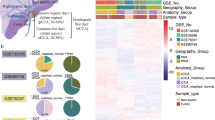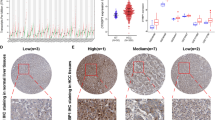Abstract
The present study was designed to investigate the upstream transcription factors (TFs) and the signature genes in cholangiocarcinoma (CCA), providing better clues on the regulatory mechanisms and therapeutic applications. Gene expression data sets of CCA were searched in the Gene Expression Omnibus database for integrated analysis. Functional annotation of differently expressed genes (DEGs) was then conducted and the TFs were identified. Moreover, a global transcriptional regulatory network of TFs–targets was constructed. Integrated analysis of five eligible Gene Expression Omnibus data sets led to a set of 993 DEGs and 48 TFs in CCA. The constructed TFs–targets regulatory network consisted of 697 TF–target interactions between 41 TFs and 436 DEGs. The top 10 TFs covering the most downstream DEGs were NFATC2, SOX10, ARID3A, ZNF263, NR4A2, GATA3, EGR1, PLAG1, STAT3 and FOSL1, which may have important roles in the tumorigenesis of CCA. Supporting the fact that defects of cell-cycle surveillance mechanism were closely related to various cancers, we found that cell cycle was the most significantly enriched pathway. KCNN2 and ADCY6 were involved in the bile secretion. Thus, their aberrant expression may be closely related to the pathogenesis of CCA. Particularly, we found that upregulation of EZH2 in CCA is a powerful potential marker for CCA.
This is a preview of subscription content, access via your institution
Access options
Subscribe to this journal
Receive 12 print issues and online access
$259.00 per year
only $21.58 per issue
Buy this article
- Purchase on Springer Link
- Instant access to full article PDF
Prices may be subject to local taxes which are calculated during checkout


Similar content being viewed by others
References
Patel T . Increasing incidence and mortality of primary intrahepatic cholangiocarcinoma in the United States. Hepatology 2001; 33: 1353–1357.
Razumilava N, Gores GJ . Cholangiocarcinoma. Lancet 2014; 383: 2168–2179.
Liu XF, Zhou XT, Zou SQ . An analysis of 680 cases of cholangiocarcinoma from 8 hospitals. Hepatobiliary Pancreat Dis Int 2005; 4: 585–588.
Tamada K, Ushio J, Sugano K . Endoscopic diagnosis of extrahepatic bile duct carcinoma: Advances and current limitations. World J Clin Oncol 2011; 2: 203–216.
Qin XL, Wang ZR, Shi JS, Lu M, Wang L, He QR . Utility of serum CA19-9 in diagnosis of cholangiocarcinoma: in comparison with CEA. World J Gastroenterol 2004; 10: 427–432.
Caldas C, Hahn SA, Hruban RH, Redston MS, Yeo CJ, Kern SE . Detection of K-ras mutations in the stool of patients with pancreatic adenocarcinoma and pancreatic ductal hyperplasia. Cancer Res 1994; 54: 3568–3573.
Itoi T, Takei K, Shinohara Y, Takeda K, Nakamura K, Horibe T et al. K-ras codon 12 and p53 mutations in biopsy specimens and bile from biliary tract cancers. Pathol Int 1999; 49: 30–37.
Liu XF, Zhang H, Zhu SG, Zhou XT, Su HL, Xu Z et al. Correlation of p53 gene mutation and expression of P53 protein in cholangiocarcinoma. World J Gastroenterol 2006; 12: 4706–4709.
Liu XF, Tang K, Sui LL, Xu G . Cholangiocarcinoma: Present Status and Molecular Aspects of Diagnosis. Oncol Res 2015; 22: 177–183.
Aishima SI, Taguchi KI, Sugimachi K, Shimada M, Sugimachi K, Tsuneyoshi M . c-erbB-2 and c-Met expression relates to cholangiocarcinogenesis and progression of intrahepatic cholangiocarcinoma. Histopathology 2002; 40: 269–278.
Ito Y, Takeda T, Sasaki Y, Sakon M, Monden M, Yamada T et al. Bcl-2 expression in cholangiocellular carcinoma is inversely correlated with biologically aggressive phenotypes. Oncology 2000; 59: 63–67.
Argani P, Shaukat A, Kaushal M, Wilentz RE, Su GH, Sohn TA et al. Differing rates of loss of DPC4 expression and of p53 overexpression among carcinomas of the proximal and distal bile ducts. Cancer 2001; 91: 1332–1341.
Braconi C, Huang N, Patel T . MicroRNA-dependent regulation of DNA methyltransferase-1 and tumor suppressor gene expression by interleukin-6 in human malignant cholangiocytes. Hepatology 2010; 51: 881–890.
Hofmann JJ, Zovein AC, Koh H, Radtke F, Weinmaster G, Iruela-Arispe ML . Jagged1 in the portal vein mesenchyme regulates intrahepatic bile duct development: insights into Alagille syndrome. Development 2010; 137: 4061–4072.
Sirica AE, Nathanson MH, Gores GJ, Larusso NF . Pathobiology of biliary epithelia and cholangiocarcinoma: proceedings of the Henry M. and Lillian Stratton Basic Research Single-Topic Conference. Hepatology 2008; 48: 2040–2046.
El Khatib M, Kalnytska A, Palagani V, Kossatz U, Manns MP, Malek NP et al. Inhibition of hedgehog signaling attenuates carcinogenesis in vitro and increases necrosis of cholangiocellular carcinoma. Hepatology 2013; 57: 1035–1045.
Maemura K, Natsugoe S, Takao S . Molecular mechanism of cholangiocarcinoma carcinogenesis. J Hepatobiliary Pancreat Sci 2014; 21: 754–760.
Barrett T, Wilhite SE, Ledoux P, Evangelista C, Kim IF, Tomashevsky M et al. NCBI GEO: archive for functional genomics data sets—update. Nucleic Acids Res 2013; 41 (Database issue): D991–D995.
Huang DW, Sherman BT, Tan Q, Collins JR, Alvord WG, Roayaei J et al. The DAVID Gene Functional Classification Tool: a novel biological module-centric algorithm to functionally analyze large gene lists. Genome Biol 2007; 8: R183.
Knuppel R, Dietze P, Lehnberg W, Frech K, Wingender E . TRANSFAC retrieval program: a network model database of eukaryotic transcription regulating sequences and proteins. J Comput Biol 1994; 1: 191–198.
Shannon P, Markiel A, Ozier O, Baliga NS, Wang JT, Ramage D et al. Cytoscape: a software environment for integrated models of biomolecular interaction networks. Genome Res 2003; 13: 2498–2504.
Tetzlaff MT, Torres-Cabala CA, Pattanaprichakul P, Rapini RP, Prieto VG, Curry JL . Emerging clinical applications of selected biomarkers in melanoma. Clin Cosmet Investig Dermatol 2015; 8: 35–46.
Cimino-Mathews A, Subhawong AP, Elwood H, Warzecha HN, Sharma R, Park BH et al. Neural crest transcription factor Sox10 is preferentially expressed in triple-negative and metaplastic breast carcinomas. Hum Pathol 2013; 44: 959–965.
Kim SB, Lee SH, Gu MJ . Esophageal subepithelial lesion diagnosed as malignant gastrointestinal neuroectodermal tumor. World J Gastroenterol 2015; 21: 5739–5743.
Tian F, Cheng L, Li D, Liu Z, Zeng Y, Xu J et al. Downregulation of mucins in graft bile ducts after liver transplantation in rats. Transplantation 2011; 92: 529–535.
Rotellini M, Palomba A, Baroni G, Franchi A . Diagnostic utility of PLAG1 immunohistochemical determination in salivary gland tumors. Appl Immunohistochem Mol Morphol 2014; 22: 390–394.
Sasaki M, Nakanuma Y . Cellular senescence in biliary pathology. Special emphasis on expression of a polycomb group protein EZH2 and a senescent marker p16INK4a in bile ductular tumors and lesions. Histol Histopathol 2015; 30: 267–275.
Sasaki M, Matsubara T, Yoneda N, Nomoto K, Tsuneyama K, Sato Y et al. Overexpression of enhancer of zeste homolog 2 and MUC1 may be related to malignant behaviour in intraductal papillary neoplasm of the bile duct. Histopathology 2013; 62: 446–457.
Nakagawa S, Okabe H, Sakamoto Y, Hayashi H, Hashimoto D, Yokoyama N et al. Enhancer of zeste homolog 2 (EZH2) promotes progression of cholangiocarcinoma cells by regulating cell cycle and apoptosis. Ann Surg Oncol 2013; 20 (Suppl 3): S667–S675.
Ketel CS, Andersen EF, Vargas ML, Suh J, Strome S, Simon JA . Subunit contributions to histone methyltransferase activities of fly and worm polycomb group complexes. Mol Cell Biol 2005; 25: 6857–6868.
Feranchak AP, Doctor RB, Troetsch M, Brookman K, Johnson SM, Fitz JG . Calcium-dependent regulation of secretion in biliary epithelial cells: the role of apamin-sensitive SK channels. Gastroenterology 2004; 127: 903–913.
Li GQ, Zhang HF . Mad2 and p27 expression profiles in colorectal cancer and its clinical significance. World J Gastroenterol 2004; 10: 3218–3220.
Choi JW, Kim Y, Lee JH, Kim YS . High expression of spindle assembly checkpoint proteins CDC20 and MAD2 is associated with poor prognosis in urothelial bladder cancer. Virchows Arch 2013; 463: 681–687.
Wada N, Yoshida A, Miyagi Y, Yamamoto T, Nakayama H, Suganuma N et al. Overexpression of the mitotic spindle assembly checkpoint genes hBUB1, hBUBR1 and hMAD2 in thyroid carcinomas with aggressive nature. Anticancer Res 2008; 28: 139–144.
Zhang SH, Xu AM, Chen XF, Li DH, Sun MP, Wang YJ . Clinicopathologic significance of mitotic arrest defective protein 2 overexpression in hepatocellular carcinoma. Hum Pathol 2008; 39: 1827–1834.
Hisaoka M, Matsuyama A, Hashimoto H . Aberrant MAD2 expression in soft-tissue sarcoma. Pathol Int 2008; 58: 329–333.
Yu L, Guo WC, Zhao SH, Tang J, Chen JL . Mitotic arrest defective protein 2 expression abnormality and its clinicopathologic significance in human osteosarcoma. APMIS 2010; 118: 222–229.
Park PE, Jeong JY, Kim SZ, Park JY . MAD2 Expression in Ovarian Carcinoma: Different Expression Patterns and Levels among Various Types of Ovarian Carcinoma and Its Prognostic Significance in High-Grade Serous Carcinoma. Korean J Pathol 2013; 47: 418–425.
Li L, Xu DB, Zhao XL, Hao TY . Combination analysis of Bub1 and Mad2 expression in endometrial cancer: act as a prognostic factor in endometrial cancer. Arch Gynecol Obstet 2013; 288: 155–165.
Hannisdal K, Burum-Auensen E, Schjolberg A, De Angelis PM, Clausen OP . Correlation between reduced expression of the spindle checkpoint protein BubR1 and bad prognosis in tonsillar carcinomas. Head Neck 2010; 32: 1354–1362.
Rizzardi C, Torelli L, Schneider M, Giudici F, Zandona L, Biasotto M et al. MAD2 expression in oral squamous cell carcinoma and its relationship to tumor grade and proliferation. Anticancer Res 2014; 34: 7021–7027.
Wang Z, Katsaros D, Shen Y, Fu Y, Canuto EM, Benedetto C et al. Biological and Clinical Significance of MAD2L1 and BUB1, Genes Frequently Appearing in Expression Signatures for Breast Cancer Prognosis. PLoS One 2015; 10: e0136246.
Author information
Authors and Affiliations
Corresponding author
Ethics declarations
Competing interests
The authors declare no conflict of interest.
Additional information
Supplementary Information accompanies the paper on Cancer Gene Therapy website
Rights and permissions
About this article
Cite this article
Yang, L., Feng, S. & Yang, Y. Identification of transcription factors (TFs) and targets involved in the cholangiocarcinoma (CCA) by integrated analysis. Cancer Gene Ther 23, 439–445 (2016). https://doi.org/10.1038/cgt.2016.64
Received:
Revised:
Accepted:
Published:
Issue Date:
DOI: https://doi.org/10.1038/cgt.2016.64
This article is cited by
-
Identification of Pathogenic Genes and Transcription Factors in Osteosarcoma
Pathology & Oncology Research (2020)
-
CDK7 inhibitor THZ1 inhibits MCL1 synthesis and drives cholangiocarcinoma apoptosis in combination with BCL2/BCL-XL inhibitor ABT-263
Cell Death & Disease (2019)
-
ACGH detects distinct genomic alterations of primary intrahepatic cholangiocarcinomas and matched lymph node metastases and identifies a poor prognosis subclass
Scientific Reports (2018)



